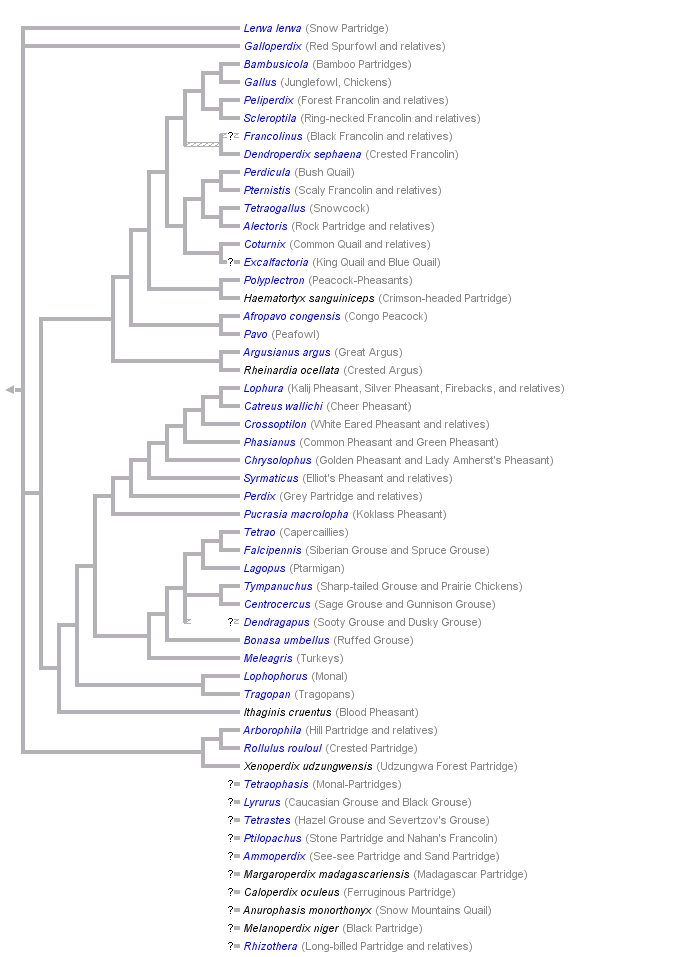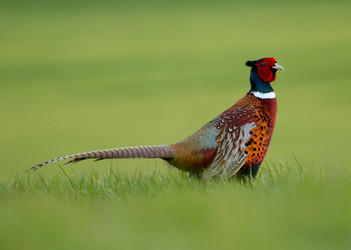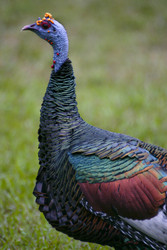Phasianidae
Chickens, Grouse, Partridges, Quail, Pheasants, etc.
Julia Gulka and David P. Mindell


This tree diagram shows the relationships between several groups of organisms.
The root of the current tree connects the organisms featured in this tree to their containing group and the rest of the Tree of Life. The basal branching point in the tree represents the ancestor of the other groups in the tree. This ancestor diversified over time into several descendent subgroups, which are represented as internal nodes and terminal taxa to the right.

You can click on the root to travel down the Tree of Life all the way to the root of all Life, and you can click on the names of descendent subgroups to travel up the Tree of Life all the way to individual species.
For more information on ToL tree formatting, please see Interpreting the Tree or Classification. To learn more about phylogenetic trees, please visit our Phylogenetic Biology pages.
close boxReferences
Bush KL, Strobeck C. 2003. Phylogenetic relationships of the phasianidae reveals possible non-pheasant taxa. J. Hered. 94:472-89.
Christidis, L. and Boles, W.E. 2008. Systematics and Taxonomy of Australian Birds. CISRO Publishing, Collingwood, VIC, Australia.
Crowe, T.M., Bowie, R.C.K., Bloomer, P., Mandiwana, T.G., Hedderson, T.A.J., Randi, E., Pereira, S.L. and Wakeling, J. 2006. Phylogenetics, biogeography and classification of, and characteristic evolution in, gamesbirds (Aves:Galliformes):effects of character exclusio, data partitioning and missing data. Cladistics 22: 495-532.
Delacour, J. 1977. The pheasants of the world. Second edition. Spur Publications and World Pheasant Association, Reading, UK.
Dimcheff, D. E., S. V. Drovetski, M. Krishnan, and D. P. Mindell. 2000. Cospeciation and horizontal transmission of avian sarcoma and leukosis virus gag genes in galliform birds. J. Virology 74:3984-3995.
Dimcheff, D. D., S. V. Drovetski, and D. P. Mindell. 2002. Molecular evolution and systematics of Tetraoninae and other Galliformes using mitochondrial 12S and ND2 genes. Molecular Phylogenetics and Evolution 24: 203-215.
Drovetski, S.V. 2002. Molecular Phylogeny of Grouse: The performance of W-linked, autosomal, and mitochondrial loci, Syst. Biol. 51:930–945.
Ellsworth, D. L., R. L. Honeycutt, and N. J. Silvy. (1996). Systematics of grouse and ptarmigan determined by nucleotide sequences of the mitochondrial cytochrome-B gene. The Auk, 113:811-822.
Eo, S. H., O. R. P. Binidia-Emonds, and J. P. Carroll. 2009. A phylogenetic supertree of the fouls (Galloansarae, Aves). Zoologica Scripta 38: 465-481.
Gill, F. and M. Wright. 2006. Birds of the World: Recommended English Names. Princeton NJ: Princeton University Press.
Gutierrez, R.J., Barrowclough, G.F., and Groth, J.G. 2000. A classification of the grouse (Aves: Tetraoninae) based on mitochodrial DNA sequences. Wildlife Biol. 6:205–211.
Kimball, R. T., C. M. St. Mary, and E. L. Braun. 2011. A macroevolutionary perspective on multiple sexual traits in the Phasianidae (Galliformes). International Journal of Evolutionary Biology 2011.
Madge, S., N. Arlott, and P. J. K. McGowan. 2000. Pheasants, Partidges, Grouse and Sandgrouse. London: Christopher Helm.
McGowan, P.J.K. 1994. Phasianidae (Pheasants and Partridges). Pages 434-552 in Handbook of the Birds of the World. del Hoyo, J., Elliott, A. and Sargatal, J., eds. Lynx Edicions, Barcelona, Spain.
Title Illustrations

| Location | Portugal |
|---|---|
| Specimen Condition | Live Specimen |
| Source | Perdiz-vermelha - Alectoris rufa |
| Source Collection | Flickr |
| Image Use |
 This media file is licensed under the Creative Commons Attribution-NonCommercial-NoDerivs License - Version 2.0. This media file is licensed under the Creative Commons Attribution-NonCommercial-NoDerivs License - Version 2.0.
|
| Copyright | © 2006 Julio Caldas |
| Scientific Name | Phasianus colchicus |
|---|---|
| Specimen Condition | Live Specimen |
| Sex | Male |
| Source | The Famous... |
| Source Collection | Flickr |
| Image Use |
 This media file is licensed under the Creative Commons Attribution-NonCommercial-NoDerivs License - Version 2.0. This media file is licensed under the Creative Commons Attribution-NonCommercial-NoDerivs License - Version 2.0.
|
| Copyright | © 2006 Ewan |
| Scientific Name | Meleagris ocellata |
|---|---|
| Location | Tikal, Guatemala |
| Specimen Condition | Live Specimen |
| Source | Oscellated turkey |
| Source Collection | Flickr |
| Image Use |
 This media file is licensed under the Creative Commons Attribution-NonCommercial License - Version 2.0. This media file is licensed under the Creative Commons Attribution-NonCommercial License - Version 2.0.
|
| Copyright | © 2007 Brian Gratwicke |
About This Page

Middlebury College, Middlebury, Vermont, USA
David P. Mindell

California Academy of Sciences, San Francisco, California, USA
Correspondence regarding this page should be directed to Julia Gulka at and David P. Mindell at
Page copyright © 2011 and David P. Mindell
 Page: Tree of Life
Phasianidae. Chickens, Grouse, Partridges, Quail, Pheasants, etc..
Authored by
Julia Gulka and David P. Mindell.
The TEXT of this page is licensed under the
Creative Commons Attribution-NonCommercial License - Version 3.0. Note that images and other media
featured on this page are each governed by their own license, and they may or may not be available
for reuse. Click on an image or a media link to access the media data window, which provides the
relevant licensing information. For the general terms and conditions of ToL material reuse and
redistribution, please see the Tree of Life Copyright
Policies.
Page: Tree of Life
Phasianidae. Chickens, Grouse, Partridges, Quail, Pheasants, etc..
Authored by
Julia Gulka and David P. Mindell.
The TEXT of this page is licensed under the
Creative Commons Attribution-NonCommercial License - Version 3.0. Note that images and other media
featured on this page are each governed by their own license, and they may or may not be available
for reuse. Click on an image or a media link to access the media data window, which provides the
relevant licensing information. For the general terms and conditions of ToL material reuse and
redistribution, please see the Tree of Life Copyright
Policies.
- First online 07 March 2007
- Content changed 23 July 2011
Citing this page:
Gulka, Julia and David P. Mindell. 2011. Phasianidae. Chickens, Grouse, Partridges, Quail, Pheasants, etc.. Version 23 July 2011 (temporary). http://tolweb.org/Phasianidae/26302/2011.07.23 in The Tree of Life Web Project, http://tolweb.org/











 Go to quick links
Go to quick search
Go to navigation for this section of the ToL site
Go to detailed links for the ToL site
Go to quick links
Go to quick search
Go to navigation for this section of the ToL site
Go to detailed links for the ToL site